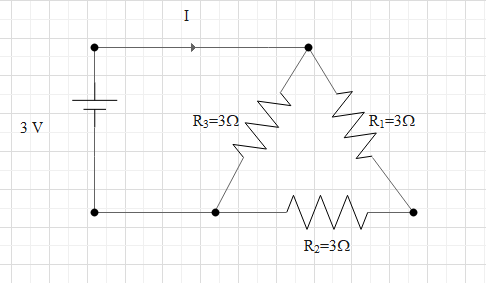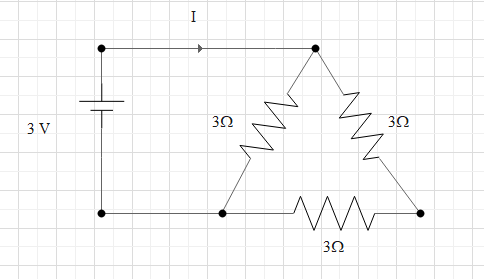Answer
64.8k+ views
Hint:We can use ohm's law to solve this question. According to ohm's law voltage is directly proportional to current. If we find the total effective resistance in the circuit then we can find the value of current. The total resistance in series will be the sum of individual resistances and the total resistance in parallel can be found by adding the reciprocals of individual resistance and then taking the reciprocal of the total sum obtained.
Complete step by step solution:
It is given that the voltage in the circuit is $V = 3\,V$
The internal resistance of the battery is negligible so it can be taken as zero.
Three resistance are connected in the circuit. We need to find the current flowing through the circuit for the given arrangement of resistors.
We know that from ohm's law voltage is directly proportional to current.
$V \propto I$
That is ,
$V = IR$
Where V is the voltage, I is the current and R is the resistance.
If we know the total resistance of the circuit then we can find the current flowing through the circuit using this formula.
So, let's find the effective resistance of the given arrangement.
Let us name the resistors as ${R_1}$, ${R_2}$ and ${R_3}$ as shown below

We can see that ${R_1}$ and ${R_2}$ are in series since only one end is connected.
When resistances are connected in series the total resistance is given by the sum of individual resistance.
${R_S} = {R_1} + {R_2}$
Using this the total resistance here is
${R_S} = 3 + 3 = 6\,\Omega $
Now from the figure we can see that this effective series resistance is parallel to ${R_3}$ since both ends of ${R_3}$ are connected to the two ends of effective series resistance.
When resistors are connected in parallel total resistance is given as
$\dfrac{1}{{{R_P}}} = \dfrac{1}{{{R_1}}} + \dfrac{1}{{{R_2}}}$
Here the resistance in parallel are ${R_S}$ and ${R_3}$
Thus, we can write,
$\dfrac{1}{{{R_P}}} = \dfrac{1}{{{R_S}}} + \dfrac{1}{{{R_3}}}$
$ \Rightarrow \dfrac{1}{{{R_P}}} = \dfrac{1}{6} + \dfrac{1}{3}$
$ \Rightarrow \dfrac{1}{{{R_P}}} = \dfrac{3}{6}$
$\therefore {R_P} = 2\Omega $
This is the net resistance in the given circuit.
Let us substitute this value in the equation for ohm's law.
$V = IR$
$ \Rightarrow 3 = I \times 2$
$\therefore I = 1.5\,A$
This is the current flowing in the circuit.
Therefore, the correct answer is option B.
Note: While calculating the effective resistance don’t think that the three resistances are in series since they are arranged end to end. Consider the potential at the ends to check whether the connection is series or parallel. The two ends of ${R_3}$ and the ends of the branch containing ${R_2}$ and ${R_1}$ are connected together. And only one end of ${R_1}$ is connected to ${R_2}$ .Thus ${R_1}$ and ${R_2}$ are in series and their effective resistance is parallel to ${R_3}$ .
Complete step by step solution:
It is given that the voltage in the circuit is $V = 3\,V$
The internal resistance of the battery is negligible so it can be taken as zero.
Three resistance are connected in the circuit. We need to find the current flowing through the circuit for the given arrangement of resistors.
We know that from ohm's law voltage is directly proportional to current.
$V \propto I$
That is ,
$V = IR$
Where V is the voltage, I is the current and R is the resistance.
If we know the total resistance of the circuit then we can find the current flowing through the circuit using this formula.
So, let's find the effective resistance of the given arrangement.
Let us name the resistors as ${R_1}$, ${R_2}$ and ${R_3}$ as shown below

We can see that ${R_1}$ and ${R_2}$ are in series since only one end is connected.
When resistances are connected in series the total resistance is given by the sum of individual resistance.
${R_S} = {R_1} + {R_2}$
Using this the total resistance here is
${R_S} = 3 + 3 = 6\,\Omega $
Now from the figure we can see that this effective series resistance is parallel to ${R_3}$ since both ends of ${R_3}$ are connected to the two ends of effective series resistance.
When resistors are connected in parallel total resistance is given as
$\dfrac{1}{{{R_P}}} = \dfrac{1}{{{R_1}}} + \dfrac{1}{{{R_2}}}$
Here the resistance in parallel are ${R_S}$ and ${R_3}$
Thus, we can write,
$\dfrac{1}{{{R_P}}} = \dfrac{1}{{{R_S}}} + \dfrac{1}{{{R_3}}}$
$ \Rightarrow \dfrac{1}{{{R_P}}} = \dfrac{1}{6} + \dfrac{1}{3}$
$ \Rightarrow \dfrac{1}{{{R_P}}} = \dfrac{3}{6}$
$\therefore {R_P} = 2\Omega $
This is the net resistance in the given circuit.
Let us substitute this value in the equation for ohm's law.
$V = IR$
$ \Rightarrow 3 = I \times 2$
$\therefore I = 1.5\,A$
This is the current flowing in the circuit.
Therefore, the correct answer is option B.
Note: While calculating the effective resistance don’t think that the three resistances are in series since they are arranged end to end. Consider the potential at the ends to check whether the connection is series or parallel. The two ends of ${R_3}$ and the ends of the branch containing ${R_2}$ and ${R_1}$ are connected together. And only one end of ${R_1}$ is connected to ${R_2}$ .Thus ${R_1}$ and ${R_2}$ are in series and their effective resistance is parallel to ${R_3}$ .
Recently Updated Pages
Write a composition in approximately 450 500 words class 10 english JEE_Main

Arrange the sentences P Q R between S1 and S5 such class 10 english JEE_Main

What is the common property of the oxides CONO and class 10 chemistry JEE_Main

What happens when dilute hydrochloric acid is added class 10 chemistry JEE_Main

If four points A63B 35C4 2 and Dx3x are given in such class 10 maths JEE_Main

The area of square inscribed in a circle of diameter class 10 maths JEE_Main

Other Pages
A boat takes 2 hours to go 8 km and come back to a class 11 physics JEE_Main

Electric field due to uniformly charged sphere class 12 physics JEE_Main

In the ground state an element has 13 electrons in class 11 chemistry JEE_Main

According to classical free electron theory A There class 11 physics JEE_Main

Differentiate between homogeneous and heterogeneous class 12 chemistry JEE_Main

Excluding stoppages the speed of a bus is 54 kmph and class 11 maths JEE_Main




